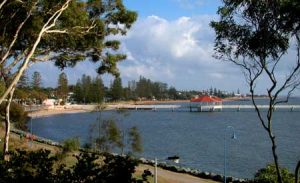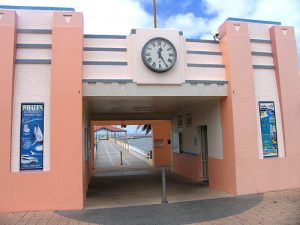
The Redcliffe Jetty has been considered the heart of the Peninsula ever since ships carrying holiday makers started arriving in the late 1800s. In those days, Brisbane residents who wanted to visit the popular seaside resort either had to embark on a four hour coach ride or a two or three hour journey by sea. In 1881 Rev John Sutton and other landowners requested that a Jetty be built at Redcliffe Point. Ratepayers signed petitions which were presented to the Caboolture Divisional Board. At the time residents had to travel to the Woody Point Jetty to catch vessels to Brisbane.

By 1885 the Jetty Construction Committee reported that the Redcliffe Jetty was finally completed. In 1889 the Jetty was extended to a length of 700 feet. In 1917 plans were drawn up for the construction of a sea wall, but this was not completed until 1919. In the same year, it was considered that it would be more economical to build a new Jetty than repair the deteriorating old one. By 1921 the Jetty was declared unsafe and closed to the public.

In 1922 the new Redcliffe Jetty was completed. At the time the two jetties sat side-by-side. Some of the ships that brought passengers to Redcliffe were the ‘Koopa’, the ‘Doomba’, the ‘Beaver’ and the ‘Marguerite’. In 1924 the Council imposed a toll of one penny per person going onto the Jetty. Three months later it was abolished, only to have it reinstated nine months later In 1928 electricity was switched on in Redcliffe and by 1930 six lights were installed on the Jetty. In 1937 the Jetty pavilion was replaced with a brick structure, then in 1938 an entertainment parlour opened in the halfway house on the Jetty. By 1961 the jetty was deteriorating and needed repair. In 1976 the Jetty was severely battered by Cyclone David, then in 1983 the Jetty decking was repaired. By 1995 plans went on display for the construction of a third Jetty, then by 1999 the third Redcliffe Jetty was finally opened.

Today the current Jetty features heritage lights, seats and drinking fountains in recognition of the two previous structures. Its concrete deck also has a railway track motif along its length. Railway tracks were an important feature of the first two jetties and were used to move cargo between the head of the jetty and Redcliffe’s main street.
 The Redcliffe Jetty has been considered the heart of the Peninsula ever since ships carrying holiday makers started arriving in the late 1800s. In those days, Brisbane residents who wanted to visit the popular seaside resort either had to embark on a four hour coach ride or a two or three hour journey by sea. In 1881 Rev John Sutton and other landowners requested that a Jetty be built at Redcliffe Point. Ratepayers signed petitions which were presented to the Caboolture Divisional Board. At the time residents had to travel to the Woody Point Jetty to catch vessels to Brisbane.
The Redcliffe Jetty has been considered the heart of the Peninsula ever since ships carrying holiday makers started arriving in the late 1800s. In those days, Brisbane residents who wanted to visit the popular seaside resort either had to embark on a four hour coach ride or a two or three hour journey by sea. In 1881 Rev John Sutton and other landowners requested that a Jetty be built at Redcliffe Point. Ratepayers signed petitions which were presented to the Caboolture Divisional Board. At the time residents had to travel to the Woody Point Jetty to catch vessels to Brisbane.
 In 1922 the new Redcliffe Jetty was completed. At the time the two jetties sat side-by-side. Some of the ships that brought passengers to Redcliffe were the ‘Koopa’, the ‘Doomba’, the ‘Beaver’ and the ‘Marguerite’. In 1924 the Council imposed a toll of one penny per person going onto the Jetty. Three months later it was abolished, only to have it reinstated nine months later In 1928 electricity was switched on in Redcliffe and by 1930 six lights were installed on the Jetty. In 1937 the Jetty pavilion was replaced with a brick structure, then in 1938 an entertainment parlour opened in the halfway house on the Jetty. By 1961 the jetty was deteriorating and needed repair. In 1976 the Jetty was severely battered by Cyclone David, then in 1983 the Jetty decking was repaired. By 1995 plans went on display for the construction of a third Jetty, then by 1999 the third Redcliffe Jetty was finally opened.
In 1922 the new Redcliffe Jetty was completed. At the time the two jetties sat side-by-side. Some of the ships that brought passengers to Redcliffe were the ‘Koopa’, the ‘Doomba’, the ‘Beaver’ and the ‘Marguerite’. In 1924 the Council imposed a toll of one penny per person going onto the Jetty. Three months later it was abolished, only to have it reinstated nine months later In 1928 electricity was switched on in Redcliffe and by 1930 six lights were installed on the Jetty. In 1937 the Jetty pavilion was replaced with a brick structure, then in 1938 an entertainment parlour opened in the halfway house on the Jetty. By 1961 the jetty was deteriorating and needed repair. In 1976 the Jetty was severely battered by Cyclone David, then in 1983 the Jetty decking was repaired. By 1995 plans went on display for the construction of a third Jetty, then by 1999 the third Redcliffe Jetty was finally opened.  Today the current Jetty features heritage lights, seats and drinking fountains in recognition of the two previous structures. Its concrete deck also has a railway track motif along its length. Railway tracks were an important feature of the first two jetties and were used to move cargo between the head of the jetty and Redcliffe’s main street.
Today the current Jetty features heritage lights, seats and drinking fountains in recognition of the two previous structures. Its concrete deck also has a railway track motif along its length. Railway tracks were an important feature of the first two jetties and were used to move cargo between the head of the jetty and Redcliffe’s main street.

